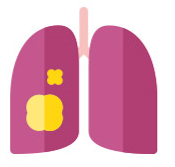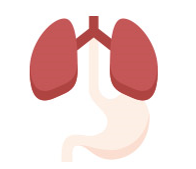What are the different types of lung cancer?
There are two main types of primary lung cancer. The type depends on the cells that the cancer started in.

Non-Small Cell Lung Cancer (NSCLC)
This the most common type at around 85% of lung cancers.

Small cell lung cancer (SCLC)
This makes up around 15% of lung cancers.
The internal and external surfaces of the body (such as the skin, bronchi and blood vessels) are covered by single- or many-cell layers of epithelial cells, which can be different shapes and have different roles.
Cancers, including NSCLC and SCLC, are divided into 4 stages using the TNM (Tumour, Node, Metastasis) staging system. For example, a Stage 1 lung cancer is small and hasn’t spread, but if a lung cancer is Stage 4 it has spread to other areas of the body (it is metastatic).
What does ‘primary’ or ‘secondary’ cancer mean?

Primary Lung Cancer
If a lung cancer begins in the lung it is called a ‘primary’ lung cancer. As lung cancers develop they become able to spread locally (within the lung) or to other areas of the body, such as the liver or brain. Lung cancer that has spread (metastasised) to another area of the body is still lung cancer and will be treated as such. For example, if a lung cancer has spread to the liver the cancer cells in the liver are still lung cancer cells.

Secondary Lung Cancer
If a cancer has spread to the lung from another part of the body it is called a ‘secondary’ cancer and is not made up of abnormal lung cells. For example, if a secondary cancer in the lung has spread from the liver, it will be made up of liver cancer cells.
Lung cancers can also be described as localised, regional or distant, depending on where they are in the body.

Localised
Localised means that the cancer is only in the lungs (this is also known as the primary site).

Regional
Regional means that the cancer has spread from the lungs to nearby lymph nodes (these are small clusters of cells that filter lymphatic fluid, and this process is also known as ’tumour extension’).

Distant
Distant means that the cancer has spread to other organs in the body (also known as ‘metastatic spread’).

